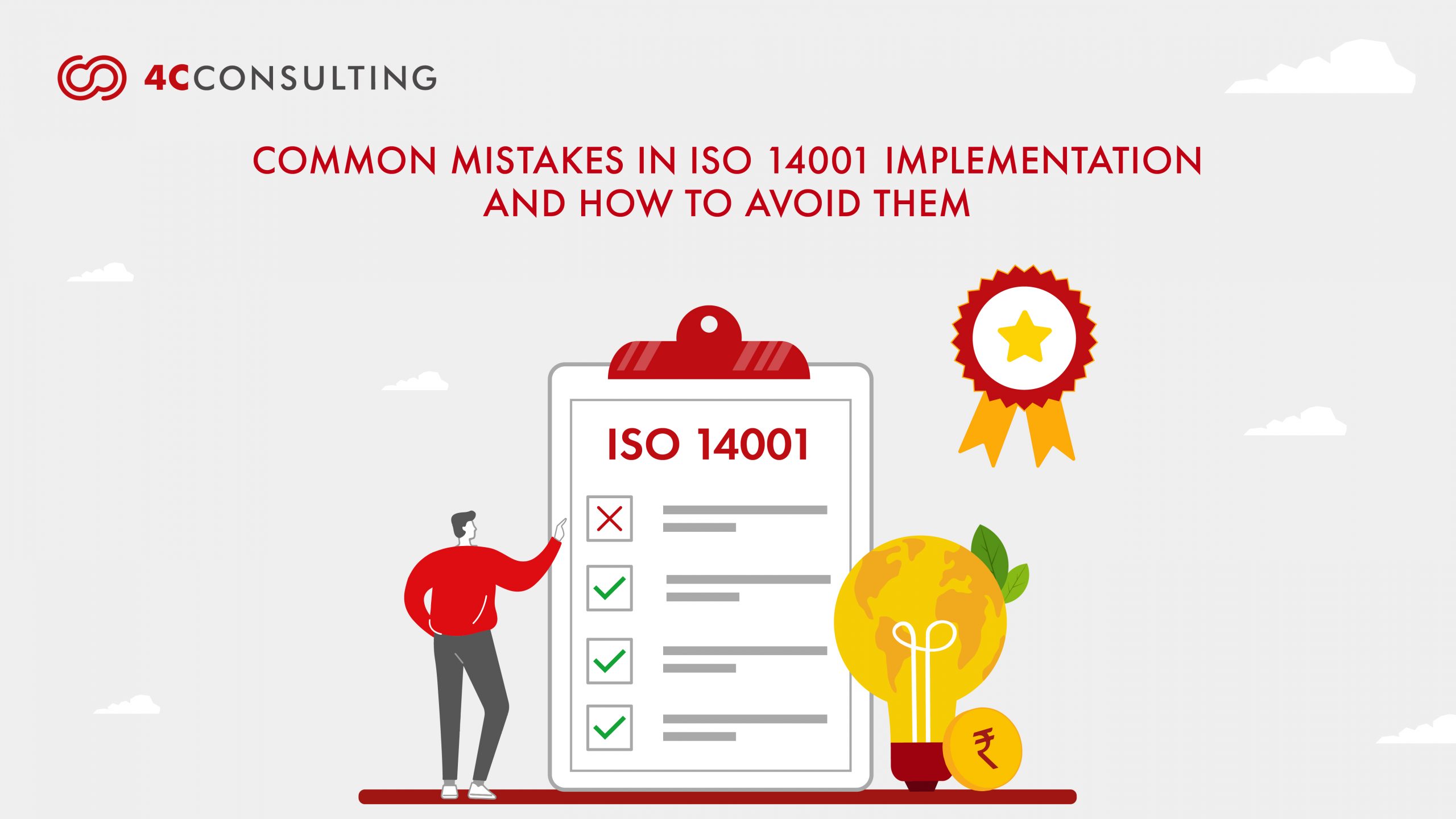
COMMON MISTAKES IN ISO 14001 IMPLEMENTATION AND HOW TO AVOID THEM
11th Oct, 2024
Did you know that 60% of businesses struggle with proper ISO 14001 implementation due to common mistakes? Achieving ISO 14001 certification not only boosts sustainability efforts but also ensures compliance with environmental management system (EMS) standards. Implementing these standards in your organization is a critical step towards improving sustainability and complying with regulatory standards. However, many companies encounter challenges throughout the implementation process. This blog highlights 11 common mistakes businesses make during ISO 14001 implementation and offers solutions to ensure successful certification.
.
OVERVIEW OF ISO 14001 CERTIFICATION
ISO 14001 is the internationally recognized standard for environmental management systems, designed to help organizations reduce their environmental impact. ISO 14001 certification helps companies enhance sustainability practices, comply with environmental regulations, and build trust among stakeholders. However, improper implementation can lead to non-compliance and missed opportunities for continuous improvement. Whether your company is ISO 14001 certified or in the process of seeking certification, understanding these common mistakes is crucial for success.
- Lack of Top Management Commitment:
Without strong support from top management, ISO certification efforts often slow down. Many organizations view certification as a task delegated to the environmental team instead of a company-wide commitment.
How to Avoid It: Successful ISO 14001 implementation requires full engagement from top management. Leadership must emphasize the importance of the environmental management system in achieving corporate sustainability goals. Clear communication, allocation of resources, and continuous oversight from management are essential for long-term success.
- Poor Employee Training and Awareness:
Employees who lack proper training on ISO 14001 requirements may not understand their role in maintaining the EMS. This leads to non-compliance and ineffective implementation.
How to Avoid It: Regular ISO 14001 training is essential to ensure all employees understand their responsibilities. Courses should cover certification requirements, environmental risks and the organization’s specific environmental policies. This ensures that everyone from senior managers to operational staff contributes to environmental sustainability.
- Focusing Only on Documentation:
Excessive focus on documentation without addressing the practical application of the EMS is a common error. Many organizations believe that detailed documentation alone will secure certification.
How to Avoid It: While documentation is crucial for the ISO 14001 certification audit, the real focus should be on improving environmental performance. ISO 14001 consulting services suggest using documentation to track performance, identify opportunities for improvement, and ensure compliance with environmental management requirements.
- Lack of Clear Objectives and KPIs:
Without measurable objectives and Key Performance Indicators (KPIs), businesses struggle to assess the effectiveness of their EMS.
How to Avoid It: Set SMART objectives (Specific, Measurable, Achievable, Relevant, Time-bound) aligned with ISO 14001 certification requirements. Regularly monitor and review KPIs to ensure that your organization is meeting its goals. ISO 14001 implementation training can help businesses establish these objectives.
- Ignoring the Need for Internal Audits:
Skipping or conducting superficial internal audits can lead to significant issues during the ISO 14001 certification process. Regular audits are critical to identifying non-conformities before they escalate.
How to Avoid It: Schedule regular ISO 14001 internal audits and ensure they are conducted by skilled personnel. Internal audits verify compliance with certification requirements and highlight areas needing improvement. Use ISO 14001 internal auditor training to equip your team with the skills needed for effective audits.
- Not Engaging Employees in the Process:
When employees are not involved in the ISO 14001 implementation process, the EMS may fail due to a lack of ownership and accountability.
How to Avoid It: Involve employees at all levels in the implementation process. ISO 14001 awareness training ensures that all employees understand how their roles contribute to environmental goals. Engaging employees in setting goals and conducting internal audits leads to a stronger commitment to sustainability.
- Inadequate Management Review and Follow-Up:
Many organizations fail to regularly review the performance of their EMS, leading to unresolved issues and missed opportunities for improvement.
How to Avoid It: Conduct regular management reviews of the EMS’s performance. This includes reviewing audit results, KPIs, and environmental objectives. Ensure that follow-up actions are assigned and completed to resolve any issues identified during the review process.
- Underestimating the Importance of Legal Compliance:
Businesses often overlook legal requirements related to ISO 14001 certification. Failing to comply with environmental laws can result in fines, penalties, and loss of certification.
How to Avoid It: Regularly review and update your EMS to ensure compliance with environmental regulations. ISO 14001 consulting firms can help identify relevant legal requirements and integrate them into your environmental management system.
- Inadequate Resources for Implementation:
Failing to allocate sufficient resources, such as personnel, time, and budget, can lead to incomplete or ineffective ISO 14001 implementation.
How to Avoid It: Allocate adequate resources to ensure the success of the EMS. This includes hiring dedicated staff for environmental management, providing ISO 14001 certification courses, and investing in necessary technology and tools. ISO 14001 certification consultants can guide businesses in optimizing their resource allocation to meet certification requirements.
- Inadequate Communication Across Departments:
Many organizations fail to ensure effective communication between departments during the ISO 14001 implementation. This can result in misaligned efforts, misunderstandings, and inconsistencies in the application of environmental management practices.
How to Avoid It: Develop clear communication channels to ensure that all departments are aligned with the ISO 14001 environmental management system. Regular cross-departmental meetings and updates can help ensure everyone is on the same page regarding environmental objectives and practices. Using ISO 14001 training sessions can help in improving communication and cooperation across teams.
- Failure to Engage External Stakeholders:
Some organizations overlook the importance of involving external stakeholders, such as suppliers and contractors in their ISO 14001 implementation. This can lead to gaps in environmental management and hinder the organization’s overall sustainability goals.
How to Avoid It: Engage key external stakeholders by communicating your organization’s environmental goals and expectations. Collaborate with suppliers to ensure that their processes align with ISO 14001 certification requirements. Incorporating environmental criteria into procurement decisions can help improve overall compliance and sustainability performance.
- Overlooking Continuous Improvement:
Many organizations achieve ISO 14001 certification but fail to focus on continuous improvement afterward. Without regular reviews and updates, the environmental management system (EMS) can become stagnant, leading to missed opportunities for improvement and non-compliance in the future.
How to Avoid It: ISO 14001 emphasizes the importance of continual improvement. Regularly review your environmental management system through audits, performance reviews, and stakeholder feedback. Use the data to identify areas for improvement and implement corrective actions. Ensure that your organization remains committed to evolving and refining its processes to stay aligned with ISO 14001 standards and to meet emerging environmental challenges.
- Overlooking the Importance of Continual Improvement:
Many organizations treat ISO 14001 certification as a one-time achievement rather than an ongoing process. Once certification is achieved, they may neglect efforts to continually improve their Environmental Management System (EMS).
How to Avoid It: ISO 14001 emphasizes continual improvement. Organizations should regularly review their EMS to identify new opportunities for enhancing environmental performance. Use data from audits, performance metrics, and feedback from stakeholders to refine processes and strive for ongoing improvements.
- Not Accounting for Lifecycle Perspective:
Some organizations fail to fully incorporate a lifecycle perspective into their EMS. This oversight can lead to gaps in managing the environmental impacts of products and services over their entire lifecycle, from raw material acquisition to disposal.
How to Avoid It: Implement the lifecycle perspective required by ISO 14001 by assessing environmental impacts at every stage of a product or service’s lifecycle. This includes not only internal processes but also supplier activities, product usage, and end-of-life disposal or recycling.
- Failing to Adapt to Changing Environmental Regulations:
Environmental regulations change over time, and failure to keep the EMS aligned with updated regulations can result in non-compliance and legal risks.
How to Avoid It: Regularly monitor changes in environmental laws and regulations relevant to your industry and region. Ensure that your EMS is flexible enough to adapt to new requirements. Regular compliance audits and consultation with ISO 14001 consultants can help you stay updated and avoid potential penalties.
ISO 14001 certification is essential for organizations aiming to improve their environmental performance and comply with regulatory requirements. By avoiding common mistake such as insufficient management commitment, poor training, and a lack of clear goals you can build a stronger and more sustainable EMS. Leveraging ISO 14001 consultant expertise and ensuring continuous employee engagement will further strengthen your EMS and ensure a successful ISO 14001 certification audit. Whether you’re just starting the ISO 14001 certification process or looking to enhance your existing EMS, working with ISO 14001 certification companies and engaging in ISO 14001 training can help you achieve long-term success.
.
WHY CHOOSE 4C CONSULTING TO ENSURE A SUCCESSFUL ISO 14001 IMPLEMENTATION?
Implementing ISO 14001 can be a complex journey, but 4C Consulting simplifies the process with over 15+ years of expertise in ISO consulting. Our team of experienced consultants and IRCA-certified auditors has successfully guided more than 3,000+ businesses across various industries, ensuring efficient ISO 14001 certification. We provide comprehensive consultancy, training, and implementation services tailored to your specific needs, delivering over 30,000+ man-days of consulting and 20,000+ hours of training. Beyond certification, we focus on continuous improvement by integrating quality tools like LEAN, Six Sigma, and TQM into your processes. With partnerships with 50+ global certification bodies and a proven track record of success, 4C Consulting is your trusted partner in achieving certification. contact us today to start your path toward ISO 14001 certification success.
